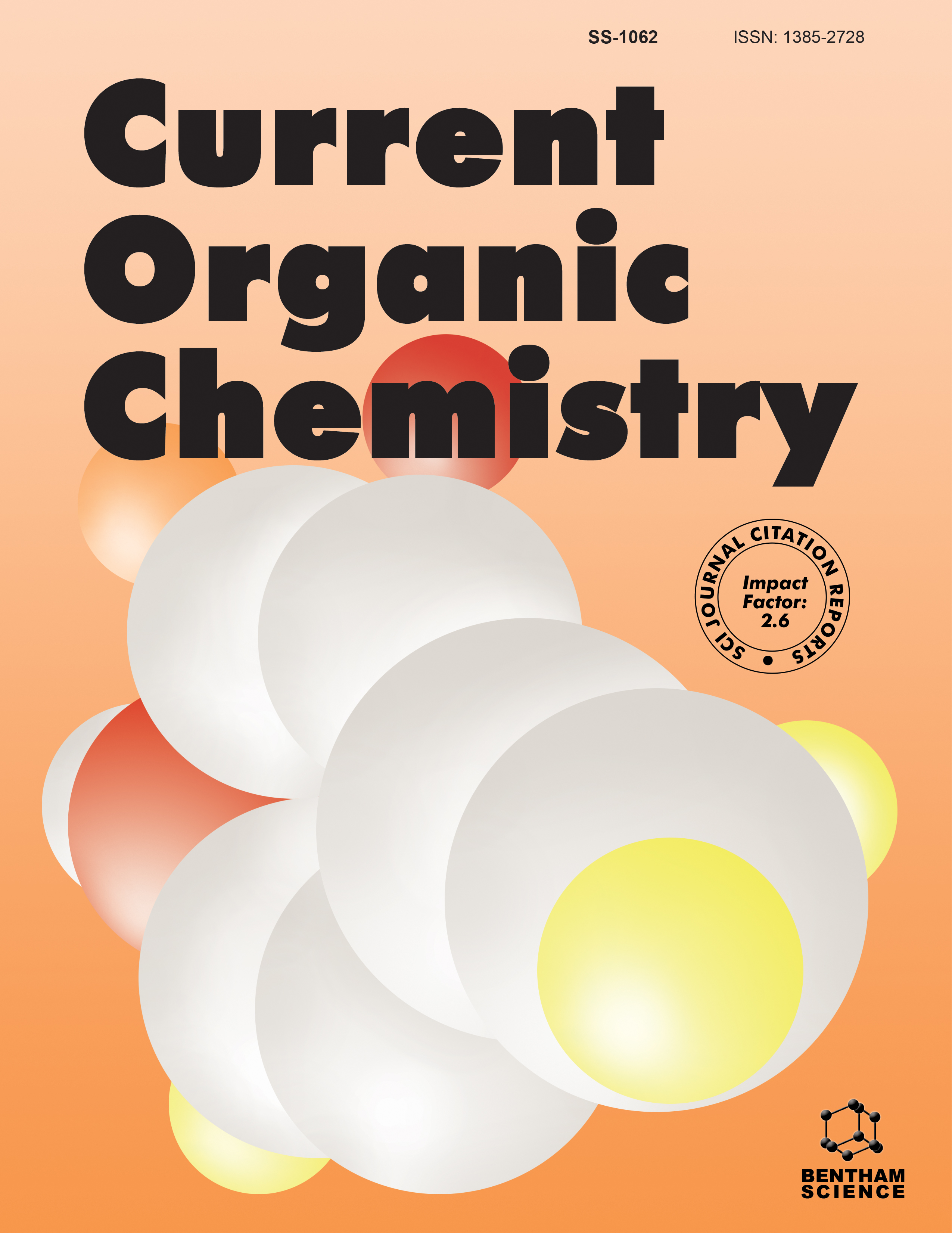- Home
- A-Z Publications
- Current Organic Chemistry
- Previous Issues
- Volume 21, Issue 4, 2017
Current Organic Chemistry - Volume 21, Issue 4, 2017
Volume 21, Issue 4, 2017
-
-
Arjunolic Acid: A Promising Antioxidant Moiety with Diverse Biological Applications
More LessAuthors: Arun Nanda, S. H. Ansari and Sarita KhatkarArjunolic acid (AA) is a triterpenoid saponin isolated mainly from Terminalia arjuna bark. Arjunolic acid is associated with the various important physiological functions viz. antioxidant, antimicrobial, cardioprotective, hepatoprotective, and plays important role in supramolecular chemistry, etc. Arjunolic acid exhibits important function in maintaining the level of various antioxidant enzymes such as superoxide dismutase (SO Read More
-
-
-
Antioxidant, Xanthine Oxidase and Monoamine Oxidase Inhibitory Potential of Coumarins: A Review
More LessAuthors: Priyanka Dhiman, Neelam Malik, Anurag Khatkar and Mahesh KulhariaExcessive and persistent formation of ROS (reactive oxygen species) is a key factor in the origin of cancer, cardiac problems, inflammatory diseases, multiple organ dysfunction, aging and neurogenerative diseases. These ROS are produced from exogenous sources (ionizing radiation, chemicals and contaminants) and endogenous sources (Enzymes like Xanthine Oxidase and Monoamine Oxidase) which further originat Read More
-
-
-
Furanodienone: An Emerging Bioactive Furanosesquiterpenoid
More LessAuthors: Federica Messina, Giulia Gigliarelli, Alfie Palmier and Maria C. MarcotullioThis review surveys the literature published on the emerging biological properties of furanodienone. Furanodienone (FDN) (1) is a furanosesquiterpenoid belonging to the class of furanogermacranes. This class of secondary metabolites is usually not widespread as they are present only in Asteraceae, Apiaceae, Myrtaceae, Lauraceae, Zingiberaceae and Burseraceae. It is commonly isolated from several spe Read More
-
-
-
Heterocyclic Antioxidants in Nature: Coumarins
More LessCoumarins represent an important family of naturally occurring and/or synthetic oxygen-containing heterocycles, bearing a characteristic benzopyrone framework. These compounds are widely distributed both in human diet and therapeutics. Among other characteristics, several coumarin derivatives proved to have an interesting antioxidant profile. In the current review, an overview of the role of natural coumari Read More
-
-
-
Hydroxytyrosol, a Phenyl Ethyl Alcohol with Health Effects
More LessOlive oil is one of the most common and important cooking oils is obtained from olive fruits. It is known as the main source of bioactive phenyl ethyl alcohol, hydroxytyrosol. Hydroxytyrosol and its derivatives representing half of the polyphenols occurring in olive oil and are responsible for the nutraceutical properties and pharmacological effects of olive oil. Hydroxytyrosol is easily absorbed and it has a good bioavailability. In ad Read More
-
-
-
Chitosan- A Naturally Derived Antioxidant Polymer with Diverse Applications
More LessAuthors: Sumit Sigroha and Anurag KhatkarChitosan is the N-deacetylated derivative of chitin which is second most available natural polymer after cellulose. Chitosan is associated with various important biological effects such as anticancer, wound healing, antimicrobial, antioxidant, as excipients in various formulations including control release drug delivery products etc. However chitosan as such is poorly soluble in water and other common solvents which may r Read More
-
-
-
Aporphine Alkaloids and their Antioxidant Medical Application: From Antineoplastic Agents to Motor Dysfunction Diseases
More LessOne of the biggest challenges in the modern medicine and the food industry is to provide chemical agents that, incorporated in the foods, could have some pharmacological properties, but mainly that can protect and preserve our health from oxidative stress, and could be used in clinical treatments against some chronic diseases with minor side effects. In this sense, aporphine alkaloids have been the group of nitrogen co Read More
-
-
-
Quercetin Effects on Exercise Induced Oxidative Stress and Inflammation
More LessQuercetin is a natural polyphenolic flavonoid, mainly present as quercetin glycosides. It is found in a wide variety of fruits, vegetables, wines and teas. Quercetin has shown a variety of biologic activities including antioxidant, anti-carcinogenic, anti-inflammatory, cardioprotective and a susceptibility reduction to viral infection. It is well established that regular and moderate exercise results in a low-moderate reactive oxy Read More
-
-
-
Chemical and Biological Properties of Phenolics in Wine: Analytical Determinations and Health Benefits
More LessSince the early 1990s, a meaningful number of reports have been published supporting the idea that wines, especially reds, encompass a series of bioactive compounds, mainly phenolic compounds, which could bring health benefits if consumed with moderation. Beyond any other alcoholic beverage, the beneficial health effect of moderate wine consumption became noteworthy after the “French Paradox” was avowed. Besi Read More
-
-
-
Silica Supported Ionic Liquid CuCl3-IL-SiO2: A Novel and Highly Efficient Catalyst for Ullmann C-N and C-O Cross-coupling Reactions Under Mild Conditions
More LessSilica supported functionalized ionic liquid CuCl3-IL-SiO2 has been prepared and characterized by FTIR, scanning electron microscopy (SEM), energy dispersive X-ray (EDX), X-ray diffraction (XRD), thermogravimetry (TG) and differential scanning calorimetry (DSC) analysis. A series of arylamines and aryl ethers were obtained by Ullmann C-N and C-O coupling of aryl halides with amines and phenols catalyzed by this ionic liquid. Th Read More
-
Volumes & issues
-
Volume 29 (2025)
-
Volume 28 (2024)
-
Volume 27 (2023)
-
Volume 26 (2022)
-
Volume 25 (2021)
-
Volume 24 (2020)
-
Volume 23 (2019)
-
Volume 22 (2018)
-
Volume 21 (2017)
-
Volume 20 (2016)
-
Volume 19 (2015)
-
Volume 18 (2014)
-
Volume 17 (2013)
-
Volume 16 (2012)
-
Volume 15 (2011)
-
Volume 14 (2010)
-
Volume 13 (2009)
-
Volume 12 (2008)
-
Volume 11 (2007)
-
Volume 10 (2006)
-
Volume 9 (2005)
-
Volume 8 (2004)
-
Volume 7 (2003)
-
Volume 6 (2002)
-
Volume 5 (2001)
-
Volume 4 (2000)
Most Read This Month
Article
content/journals/coc
Journal
10
5
false
en


